2009 Hyundai Azera airbag off
[x] Cancel search: airbag offPage 5 of 335

F4
A110A01A-AAT
VEHICLE DATA COLLECTION AND EVENT DATA RECORDERS
Your Hyundai vehicle is equipped with many high technology, electronically controlled systems
that help to ensure your vehicle operates properly and provides the performance that you
expect. These systems utilize computers to monitor the operation of various systems and
components and help to control their operation. These computerized system operations are
wide-ranging and involve components to reduce emissions, to continuously evaluate the
readiness of the airbag and seat belt pretensioner systems, to determine when the airbag and
seat belt pre-tensioner systems should be deployed and then to activate the deployment, and
if equipped, to operate anti-lock braking, traction control and electrical stability control to assist
the driver to control the vehicle in difficult driving situations. These systems electronically store
information that is useful to service technicians when they need to diagnose and repair these
systems. Additional information is stored only when a crash occurs that results in the
deployment of the airbags or seat belt pre-tensioners. This type of data storage is done by
devices called event data recorders(EDR).
After a crash event, the airbag and seat belt pre-tensioner computer system, known as the
Supplemental Restraint System Control Module (SRSCM) or Airbag Control Unit (ACU), may
record some information about the condition of the vehicle and how it was being operated. This
information consists of data related to seat belt usage and if there was diagnostic information
in the airbag or seat belt systems at the time that a crash occurred, and if the ACU sensed that
a crash of sufficient severity occurred to require seat belt pre-tensioner or airbag deployment.
To retrieve this information, special equipment is needed and access to the vehicle or the device
that stores the data is required. Hyundai will not access information about a crash event or share
it with others except:
o in response to an official request of police or similar government office, or
o with the consent of the vehicle owner or, if the vehicle is leased, with the consent of the lessee,
or
o as part of Hyundai’s defense of litigation, or
o as required by law.
Page 55 of 335
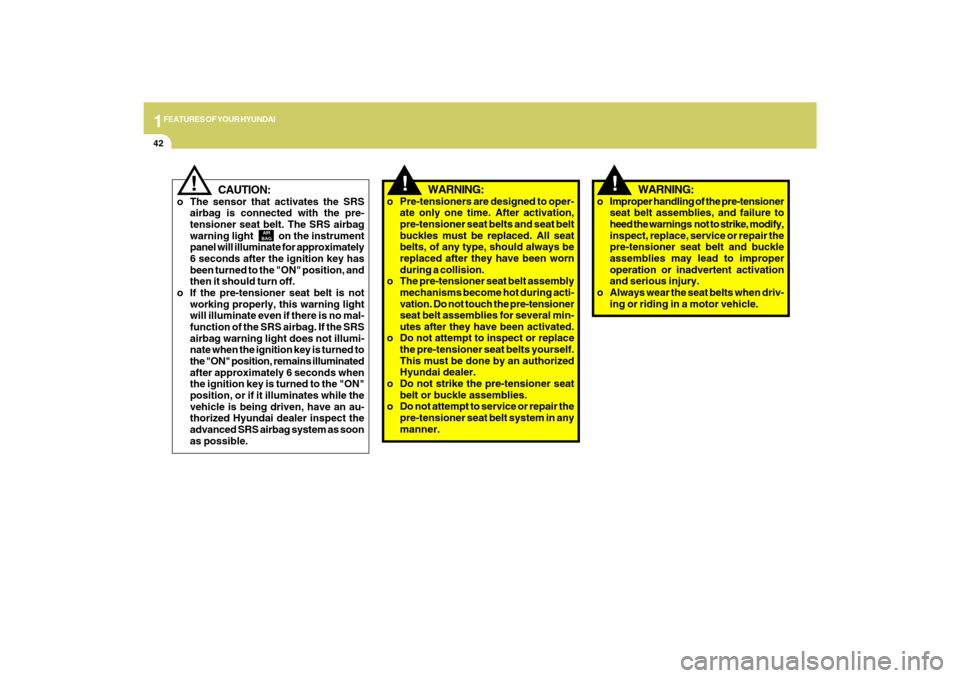
1FEATURES OF YOUR HYUNDAI42
!
WARNING:
o Improper handling of the pre-tensioner
seat belt assemblies, and failure to
heed the warnings not to strike, modify,
inspect, replace, service or repair the
pre-tensioner seat belt and buckle
assemblies may lead to improper
operation or inadvertent activation
and serious injury.
o Always wear the seat belts when driv-
ing or riding in a motor vehicle.
!
AIR
BAG
CAUTION:
o The sensor that activates the SRS
airbag is connected with the pre-
tensioner seat belt. The SRS airbag
warning light on the instrument
panel will illuminate for approximately
6 seconds after the ignition key has
been turned to the "ON" position, and
then it should turn off.
o If the pre-tensioner seat belt is not
working properly, this warning light
will illuminate even if there is no mal-
function of the SRS airbag. If the SRS
airbag warning light does not illumi-
nate when the ignition key is turned to
the "ON" position, remains illuminated
after approximately 6 seconds when
the ignition key is turned to the "ON"
position, or if it illuminates while the
vehicle is being driven, have an au-
thorized Hyundai dealer inspect the
advanced SRS airbag system as soon
as possible.
!
WARNING:
o Pre-tensioners are designed to oper-
ate only one time. After activation,
pre-tensioner seat belts and seat belt
buckles must be replaced. All seat
belts, of any type, should always be
replaced after they have been worn
during a collision.
o The pre-tensioner seat belt assembly
mechanisms become hot during acti-
vation. Do not touch the pre-tensioner
seat belt assemblies for several min-
utes after they have been activated.
o Do not attempt to inspect or replace
the pre-tensioner seat belts yourself.
This must be done by an authorized
Hyundai dealer.
o Do not strike the pre-tensioner seat
belt or buckle assemblies.
o Do not attempt to service or repair the
pre-tensioner seat belt system in any
manner.
Page 57 of 335
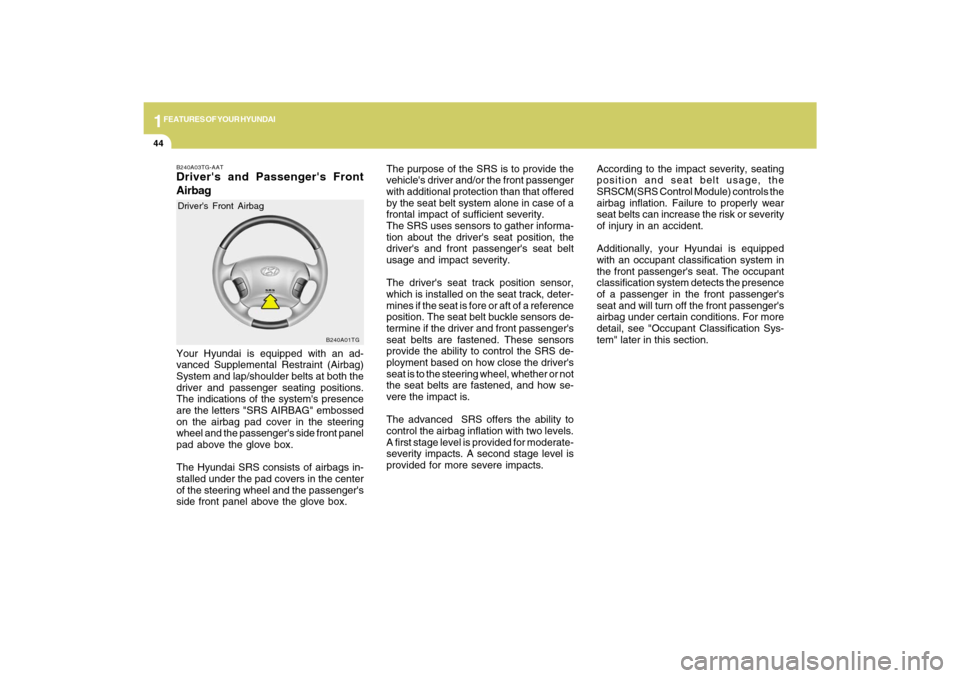
1FEATURES OF YOUR HYUNDAI44
B240A01TG
The purpose of the SRS is to provide the
vehicle's driver and/or the front passenger
with additional protection than that offered
by the seat belt system alone in case of a
frontal impact of sufficient severity.
The SRS uses sensors to gather informa-
tion about the driver's seat position, the
driver's and front passenger's seat belt
usage and impact severity.
The driver's seat track position sensor,
which is installed on the seat track, deter-
mines if the seat is fore or aft of a reference
position. The seat belt buckle sensors de-
termine if the driver and front passenger's
seat belts are fastened. These sensors
provide the ability to control the SRS de-
ployment based on how close the driver's
seat is to the steering wheel, whether or not
the seat belts are fastened, and how se-
vere the impact is.
The advanced SRS offers the ability to
control the airbag inflation with two levels.
A first stage level is provided for moderate-
severity impacts. A second stage level is
provided for more severe impacts.According to the impact severity, seating
position and seat belt usage, the
SRSCM(SRS Control Module) controls the
airbag inflation. Failure to properly wear
seat belts can increase the risk or severity
of injury in an accident.
Additionally, your Hyundai is equipped
with an occupant classification system in
the front passenger's seat. The occupant
classification system detects the presence
of a passenger in the front passenger's
seat and will turn off the front passenger's
airbag under certain conditions. For more
detail, see "Occupant Classification Sys-
tem" later in this section.
B240A03TG-AATDriver's and Passenger's Front
AirbagYour Hyundai is equipped with an ad-
vanced Supplemental Restraint (Airbag)
System and lap/shoulder belts at both the
driver and passenger seating positions.
The indications of the system's presence
are the letters "SRS AIRBAG" embossed
on the airbag pad cover in the steering
wheel and the passenger's side front panel
pad above the glove box.
The Hyundai SRS consists of airbags in-
stalled under the pad covers in the center
of the steering wheel and the passenger's
side front panel above the glove box.Driver's Front Airbag
Page 59 of 335
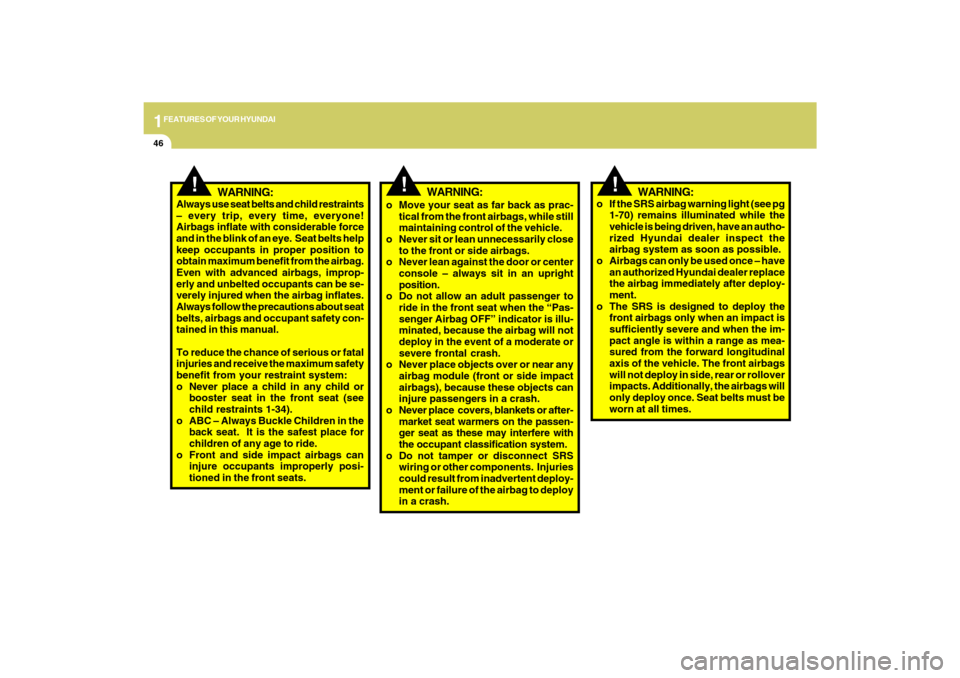
1FEATURES OF YOUR HYUNDAI46
!
WARNING:
!
WARNING:
o Move your seat as far back as prac-
tical from the front airbags, while still
maintaining control of the vehicle.
o Never sit or lean unnecessarily close
to the front or side airbags.
o Never lean against the door or center
console – always sit in an upright
position.
o Do not allow an adult passenger to
ride in the front seat when the “Pas-
senger Airbag OFF” indicator is illu-
minated, because the airbag will not
deploy in the event of a moderate or
severe frontal crash.
o Never place objects over or near any
airbag module (front or side impact
airbags), because these objects can
injure passengers in a crash.
o Never place covers, blankets or after-
market seat warmers on the passen-
ger seat as these may interfere with
the occupant classification system.
o Do not tamper or disconnect SRS
wiring or other components. Injuries
could result from inadvertent deploy-
ment or failure of the airbag to deploy
in a crash.
!
WARNING:
Always use seat belts and child restraints
– every trip, every time, everyone!
Airbags inflate with considerable force
and in the blink of an eye. Seat belts help
keep occupants in proper position to
obtain maximum benefit from the airbag.
Even with advanced airbags, improp-
erly and unbelted occupants can be se-
verely injured when the airbag inflates.
Always follow the precautions about seat
belts, airbags and occupant safety con-
tained in this manual.
To reduce the chance of serious or fatal
injuries and receive the maximum safety
benefit from your restraint system:
o Never place a child in any child or
booster seat in the front seat (see
child restraints 1-34).
o ABC – Always Buckle Children in the
back seat. It is the safest place for
children of any age to ride.
o Front and side impact airbags can
injure occupants improperly posi-
tioned in the front seats.o If the SRS airbag warning light (see pg
1-70) remains illuminated while the
vehicle is being driven, have an autho-
rized Hyundai dealer inspect the
airbag system as soon as possible.
o Airbags can only be used once – have
an authorized Hyundai dealer replace
the airbag immediately after deploy-
ment.
o The SRS is designed to deploy the
front airbags only when an impact is
sufficiently severe and when the im-
pact angle is within a range as mea-
sured from the forward longitudinal
axis of the vehicle. The front airbags
will not deploy in side, rear or rollover
impacts. Additionally, the airbags will
only deploy once. Seat belts must be
worn at all times.
Page 61 of 335
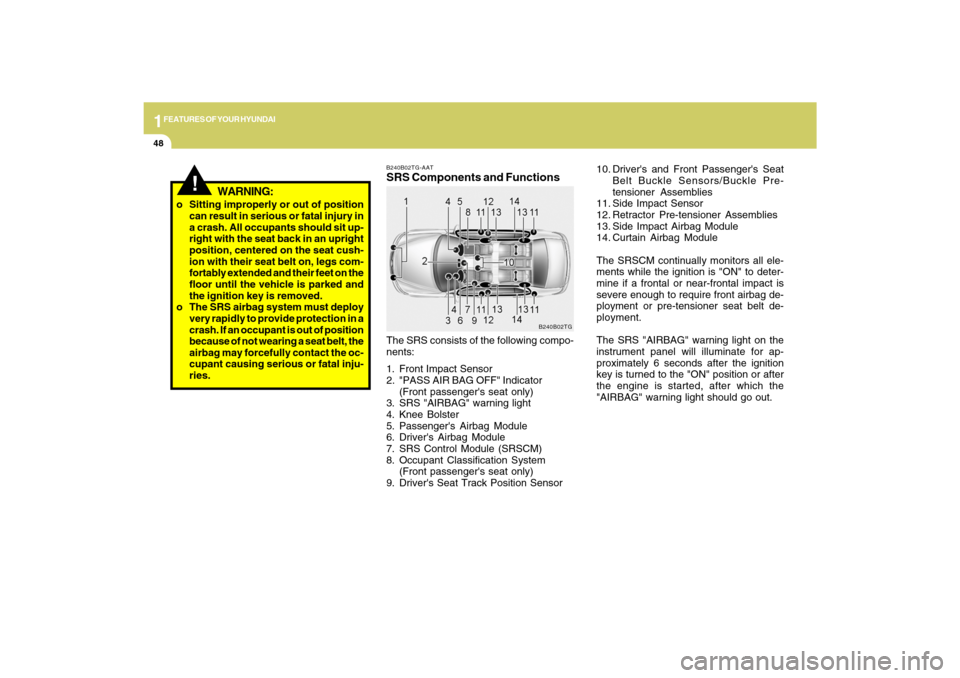
1FEATURES OF YOUR HYUNDAI48
!
o Sitting improperly or out of position
can result in serious or fatal injury in
a crash. All occupants should sit up-
right with the seat back in an upright
position, centered on the seat cush-
ion with their seat belt on, legs com-
fortably extended and their feet on the
floor until the vehicle is parked and
the ignition key is removed.
o The SRS airbag system must deploy
very rapidly to provide protection in a
crash. If an occupant is out of position
because of not wearing a seat belt, the
airbag may forcefully contact the oc-
cupant causing serious or fatal inju-
ries.
WARNING:
10. Driver's and Front Passenger's Seat
Belt Buckle Sensors/Buckle Pre-
tensioner Assemblies
11. Side Impact Sensor
12. Retractor Pre-tensioner Assemblies
13. Side Impact Airbag Module
14. Curtain Airbag Module
The SRSCM continually monitors all ele-
ments while the ignition is "ON" to deter-
mine if a frontal or near-frontal impact is
severe enough to require front airbag de-
ployment or pre-tensioner seat belt de-
ployment.
The SRS "AIRBAG" warning light on the
instrument panel will illuminate for ap-
proximately 6 seconds after the ignition
key is turned to the "ON" position or after
the engine is started, after which the
"AIRBAG" warning light should go out.
B240B02TG-AATSRS Components and FunctionsThe SRS consists of the following compo-
nents:
1. Front Impact Sensor
2. "PASS AIR BAG OFF" Indicator
(Front passenger's seat only)
3. SRS "AIRBAG" warning light
4. Knee Bolster
5. Passenger's Airbag Module
6. Driver's Airbag Module
7. SRS Control Module (SRSCM)
8. Occupant Classification System
(Front passenger's seat only)
9. Driver's Seat Track Position Sensor
B240B02TG
Page 64 of 335
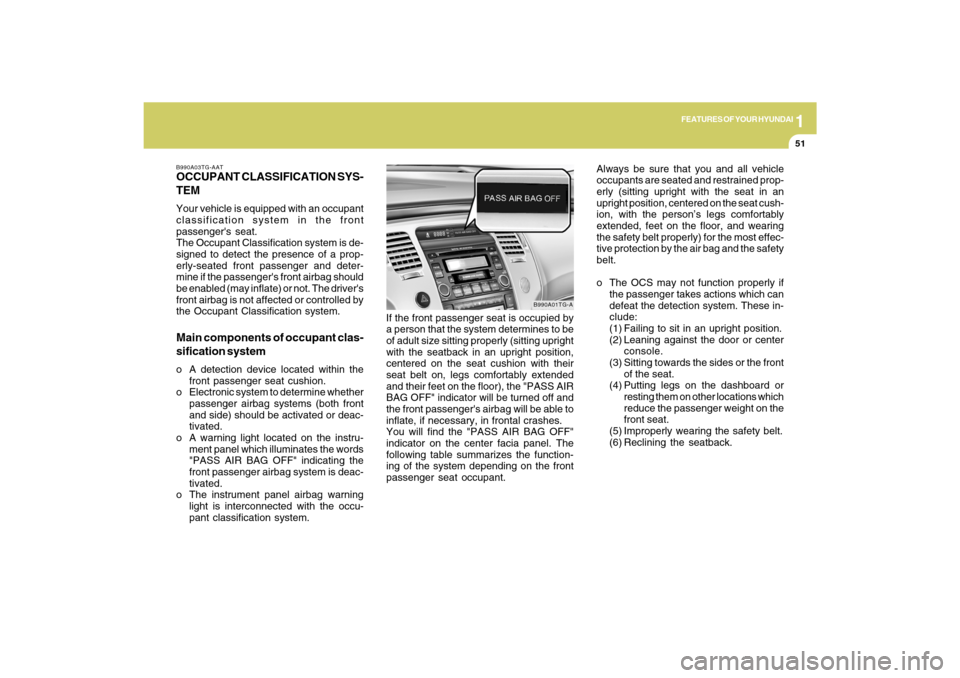
1
FEATURES OF YOUR HYUNDAI
51
B990A03TG-AATOCCUPANT CLASSIFICATION SYS-
TEMYour vehicle is equipped with an occupant
classification system in the front
passenger's seat.
The Occupant Classification system is de-
signed to detect the presence of a prop-
erly-seated front passenger and deter-
mine if the passenger's front airbag should
be enabled (may inflate) or not. The driver's
front airbag is not affected or controlled by
the Occupant Classification system.Main components of occupant clas-
sification systemo A detection device located within the
front passenger seat cushion.
o Electronic system to determine whether
passenger airbag systems (both front
and side) should be activated or deac-
tivated.
o A warning light located on the instru-
ment panel which illuminates the words
"PASS AIR BAG OFF" indicating the
front passenger airbag system is deac-
tivated.
o The instrument panel airbag warning
light is interconnected with the occu-
pant classification system.If the front passenger seat is occupied by
a person that the system determines to be
of adult size sitting properly (sitting upright
with the seatback in an upright position,
centered on the seat cushion with their
seat belt on, legs comfortably extended
and their feet on the floor), the "PASS AIR
BAG OFF" indicator will be turned off and
the front passenger's airbag will be able to
inflate, if necessary, in frontal crashes.
You will find the "PASS AIR BAG OFF"
indicator on the center facia panel. The
following table summarizes the function-
ing of the system depending on the front
passenger seat occupant.
B990A01TG-A
Always be sure that you and all vehicle
occupants are seated and restrained prop-
erly (sitting upright with the seat in an
upright position, centered on the seat cush-
ion, with the person’s legs comfortably
extended, feet on the floor, and wearing
the safety belt properly) for the most effec-
tive protection by the air bag and the safety
belt.
o The OCS may not function properly if
the passenger takes actions which can
defeat the detection system. These in-
clude:
(1) Failing to sit in an upright position.
(2) Leaning against the door or center
console.
(3) Sitting towards the sides or the front
of the seat.
(4) Putting legs on the dashboard or
resting them on other locations which
reduce the passenger weight on the
front seat.
(5) Improperly wearing the safety belt.
(6) Reclining the seatback.
Page 65 of 335
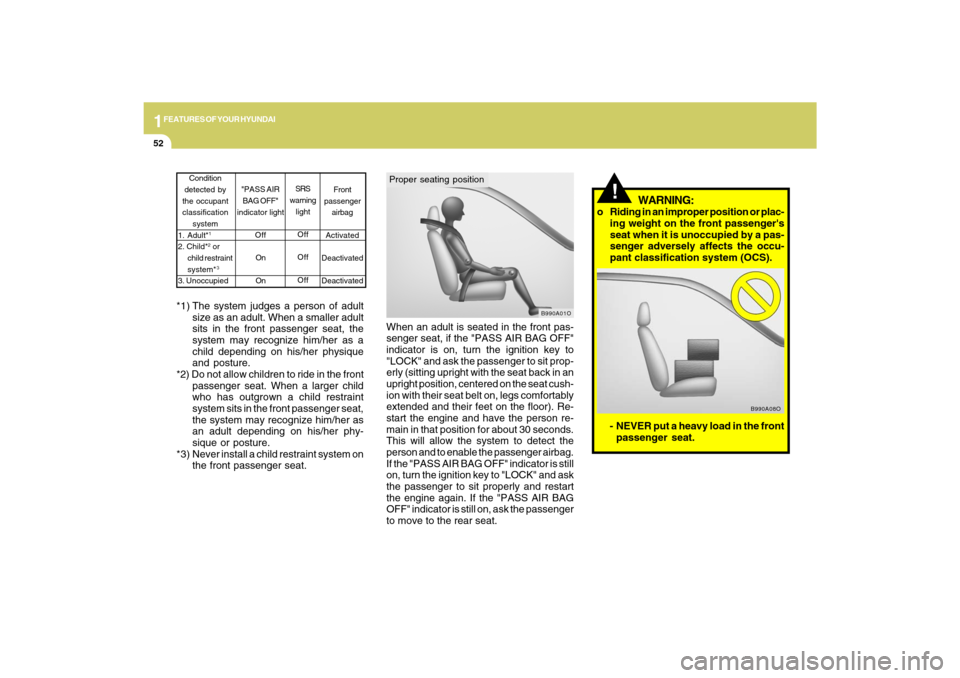
1FEATURES OF YOUR HYUNDAI52
- NEVER put a heavy load in the front
passenger seat.
B990A08O
!
WARNING:
o Riding in an improper position or plac-
ing weight on the front passenger's
seat when it is unoccupied by a pas-
senger adversely affects the occu-
pant classification system (OCS).
*1) The system judges a person of adult
size as an adult. When a smaller adult
sits in the front passenger seat, the
system may recognize him/her as a
child depending on his/her physique
and posture.
*2) Do not allow children to ride in the front
passenger seat. When a larger child
who has outgrown a child restraint
system sits in the front passenger seat,
the system may recognize him/her as
an adult depending on his/her phy-
sique or posture.
*3) Never install a child restraint system on
the front passenger seat.
Front
passenger
airbag
Activated
Deactivated
Deactivated Condition
detected by
the occupant
classification
system
1. Adult*
1
2. Child*
2 or
child restraint
system*3
3. UnoccupiedSRS
warning
light
Off
Off
Off "PASS AIR
BAG OFF"
indicator light
Off
On
On
When an adult is seated in the front pas-
senger seat, if the "PASS AIR BAG OFF"
indicator is on, turn the ignition key to
"LOCK" and ask the passenger to sit prop-
erly (sitting upright with the seat back in an
upright position, centered on the seat cush-
ion with their seat belt on, legs comfortably
extended and their feet on the floor). Re-
start the engine and have the person re-
main in that position for about 30 seconds.
This will allow the system to detect the
person and to enable the passenger airbag.
If the "PASS AIR BAG OFF" indicator is still
on, turn the ignition key to "LOCK" and ask
the passenger to sit properly and restart
the engine again. If the "PASS AIR BAG
OFF" indicator is still on, ask the passenger
to move to the rear seat.Proper seating position
B990A01O
Page 66 of 335
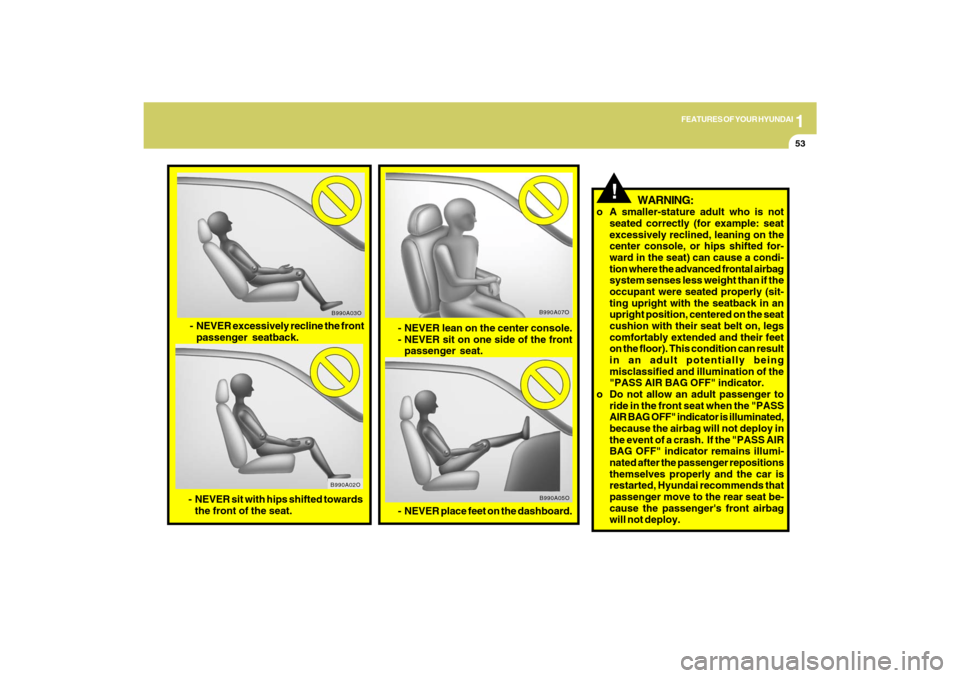
1
FEATURES OF YOUR HYUNDAI
53
- NEVER lean on the center console.
- NEVER sit on one side of the front
passenger seat.
B990A07O
B990A05O
- NEVER place feet on the dashboard.
- NEVER excessively recline the front
passenger seatback.
- NEVER sit with hips shifted towards
the front of the seat.
B990A03O
B990A02O
!
WARNING:
o A smaller-stature adult who is not
seated correctly (for example: seat
excessively reclined, leaning on the
center console, or hips shifted for-
ward in the seat) can cause a condi-
tion where the advanced frontal airbag
system senses less weight than if the
occupant were seated properly (sit-
ting upright with the seatback in an
upright position, centered on the seat
cushion with their seat belt on, legs
comfortably extended and their feet
on the floor). This condition can result
in an adult potentially being
misclassified and illumination of the
"PASS AIR BAG OFF" indicator.
o Do not allow an adult passenger to
ride in the front seat when the "PASS
AIR BAG OFF" indicator is illuminated,
because the airbag will not deploy in
the event of a crash. If the "PASS AIR
BAG OFF" indicator remains illumi-
nated after the passenger repositions
themselves properly and the car is
restarted, Hyundai recommends that
passenger move to the rear seat be-
cause the passenger's front airbag
will not deploy.